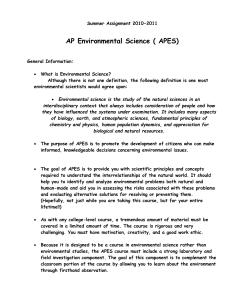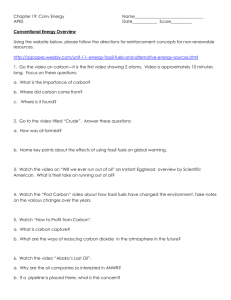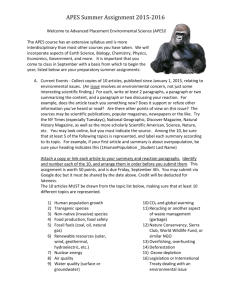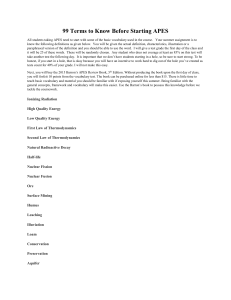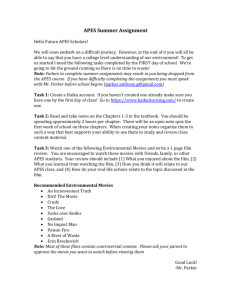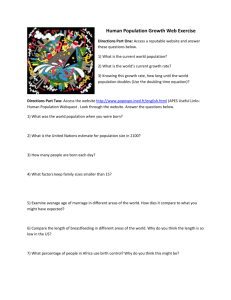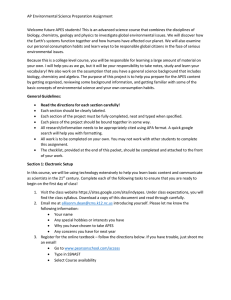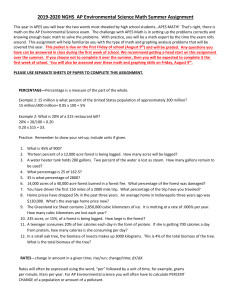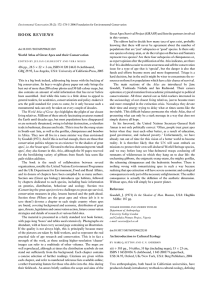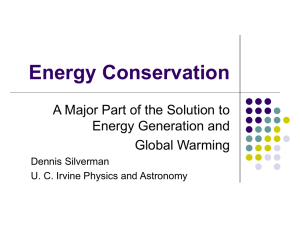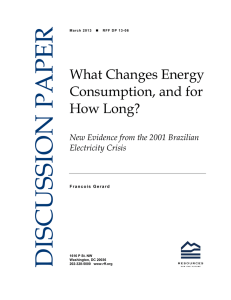Study Guide Chapter 1
advertisement
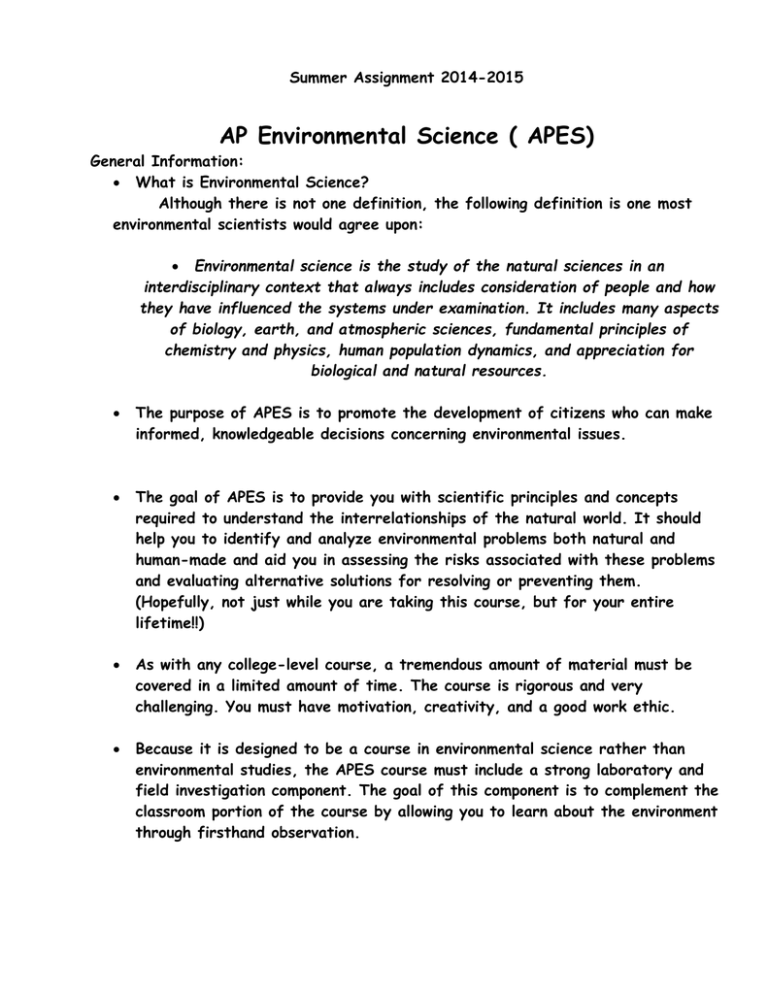
Summer Assignment 2014-2015 AP Environmental Science ( APES) General Information: What is Environmental Science? Although there is not one definition, the following definition is one most environmental scientists would agree upon: Environmental science is the study of the natural sciences in an interdisciplinary context that always includes consideration of people and how they have influenced the systems under examination. It includes many aspects of biology, earth, and atmospheric sciences, fundamental principles of chemistry and physics, human population dynamics, and appreciation for biological and natural resources. The purpose of APES is to promote the development of citizens who can make informed, knowledgeable decisions concerning environmental issues. The goal of APES is to provide you with scientific principles and concepts required to understand the interrelationships of the natural world. It should help you to identify and analyze environmental problems both natural and human-made and aid you in assessing the risks associated with these problems and evaluating alternative solutions for resolving or preventing them. (Hopefully, not just while you are taking this course, but for your entire lifetime!!) As with any college-level course, a tremendous amount of material must be covered in a limited amount of time. The course is rigorous and very challenging. You must have motivation, creativity, and a good work ethic. Because it is designed to be a course in environmental science rather than environmental studies, the APES course must include a strong laboratory and field investigation component. The goal of this component is to complement the classroom portion of the course by allowing you to learn about the environment through firsthand observation. Summer Assignment There are 4 parts to your assignment. Parts 1-3 are due on the FIRST DAY OF SCHOOL. Part 4 will be due the first week of school. Should you have any questions my email is khaines@whrhs.org. Have a great summer and “THINK GREEN” 1. A LITTLE MATH… You will be required to use math frequently in this course. you do not need any outside sources to complete these problems), they are just a sample of the type of math problems you will be doing this year. Note: calculators may not be used during the AP exam or during unit tests for this course, so try to complete it without a calculator. Please review the rules for using scientific notation. Most problems in this course assume you know how to use scientific notation without a calculator. Visit my website for some power points and tutorials to help. Show your work (set up and units)!!! No work=no credit West Freemont is a community of 3,000 homes. A small coal burning power plant currently supplies electricity for the town. The capacity of the power plant is 12 megawatts(MW) and the average household consumes 8000kilowatt hours (kWh) of electrical energy each year. The price paid to the electric utility by the residents is $0.10 per kWh. The town leaders are considering a plan, the West Fremont Wind Project(WFWP) , to generate their own electricity using 10 wind turbines that would be located on the edge of town. Each turbine would have a capacity of 1.2 MW and each would cost $3 million to purchase and operate for 25 years. A. Assuming that existing power plant can operate at full capacity for 8000hrs/year, how many kWh of electricity can be produced by the plant in a year? B. At the current rate of electrical energy use per household, how many kWh or electrical energy does the community consume in one year? C. Compare your answers in a and b and explain why you would or would not expect the numbers to be the same. D. Assuming the electrical energy needs of the community do not change during the 25 year period, what would be the cost tot the community of electricity supplied by the WFWP over 25 years? Express answer in dollars/kWh. E. Identify and explain two environmental benefits to switching from coal to wind and two environmental costs to switching from coal to wind. 2. Watch the video Home http://www.youtube.com/watch?v=jqxENMKaeCU on Youtube.com and write a reflection. ( at least one typed page, include three topics that are addressed in the video.) 3. Fill in a chart similar to the one below for each of the following pieces of legislation or treaties. There will be a quiz on these laws the second week of school. Name Function of Legislation or Treaty Established primary and secondary air quality standards. Required states to Clean develop implementation plans. Sets limits and goals to reduce mobile source Air Act air pollution and ambient air quality standards. Clean Air Act Clean Water Acts Comprehensive Environmental Response, Compensation Liability Act Convention on International Trade in Endangered Species Energy Policy Act Federal Food, Drug, and Cosmetic Act Federal Insecticide, Fungicide and Rodenticide Act Fish and Wildlife Conservation Act Unit Air Food, Drug, and Cosmetics Acts Oil Spill Prevention and Liability Act Kyoto Protocol Occupational Safety and Health Act Ocean Dumping Ban Act Endangered Species Act Pollution Prevention Act Montreal Protocol Soil and Water Conservation Act Solid Waste Disposal Act National Energy Act National Environmental Policy Act Resource Conservation and Recovery Act Oil Pollution Act Surface Mining Control and Reclamation Act Safe Drinking Water Act Food Quality Protection Act Nuclear Waste Policy Act Wilderness Act 4. I hope you will have a great summer. To get you in the right mental frame of mind for APES and expand your mind, there is a summer reading assignment. Reading is an essential component of higher education, and, therefore, we do a GREAT DEAL of it in APES. Please read the following instructions carefully. This is due the first week of school. PART 1 You must read the book Visit Sunny Chernobyl by Andrew Blackwell. You can get it at your local library or order it on amazon.com. Take handwritten notes on each section as you read. PART 2 To your reading notes from Part 1, you must staple 4 newspaper articles glued on paper concerning the environmental issues presented in the chapters in the book, each article should have a paragraph summary (at LEAST five sentences) of the article. ***BE PREPARED TO TAKE A QUIZ OVER THE IDEAS PRESENTED IN THE BOOK YOU READ THE FIRST WEEK OF SCHOOL. *** TAKE NOTES WHILE YOU READ. YOU WILL BE ALLOWED TO USE HANDWRITTEN NOTES ONLY ON THE QUIZ. YOU WILL TURN IN THE NOTES FROM THE BOOK AND THE ARTICLES THE FIRST WEEK OF SCHOOL, NO EXCEPTIONS.

